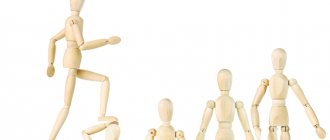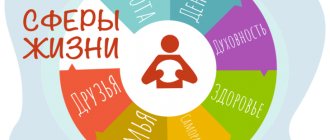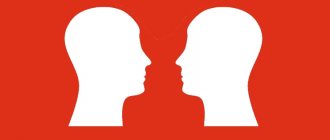Do you want to understand what the people around you really want? It's quite simple if you understand body language. The words of a partner, boss, friend or just an acquaintance may seem very true, but turn out to be a complete lie. Another thing is body language, facial expressions and gestures. This is nonverbal speech that confirms or refutes the meaning of what was said.
Everything matters: from the slightest body movement and posture to eye contact, physical distance and voice volume.
How much can you trust what your body language says? Almost one hundred percent!
Of course, there are people who deliberately use some non-verbal signals to mislead others, but with enough practice and knowledge, they are easy to see through. We have prepared for you 20 examples of body language, after studying which you will better understand the true motives of people.
What does a handshake tell you?
Shaking hands is a non-verbal gesture that is used as a greeting in many cultures. Often it also indicates the end of communication or the achievement of an agreement. This gesture is characteristic mostly of men, although business etiquette allows ladies to resort to it at the beginning and end of negotiations if representatives of the opposite sex are involved. In this case, the woman is always the first to extend her hand.
This gesture itself can tell a lot about the interlocutor. A strong-willed, open person greets with a strong handshake, squeezing the interlocutor’s hand quite tightly. People who are not very confident show a sluggish gesture, in which the hand is relaxed and the hand is located below. Such a handshake characterizes a person without initiative, lazy, and not inclined to make independent decisions. Touching the interlocutor’s hand, accompanied by slight squeezing, can also indicate the person’s delicacy and his ability to keep his distance. If you say hello briefly, the interlocutor puts his hands behind his back or puts them in his pockets, thus demonstrating superiority.
Open people extend their hand to their “vis-a-vis”, bending it at the elbow and wrist only slightly. Secretive or deceitful people, on the contrary, try to keep the limb bent. Their forearm remains pressed to the body, while the hand is directed almost vertically. If, when shaking hands, such a person tries to press the interlocutor’s hand down, this characterizes him as cruel and rather domineering. Independent individuals try to maintain maximum distance, practically without bending their hand when shaking hands.
Features of facial expressions
His facial expressions can say a lot about a person and his mood. Nonverbal gestures reflected on the face may indicate the following:
- narrowed eyes and pursed lips indicate an angry mood;
- raised eyebrows and wide open eyes mean surprise;
- in a state of fear, the lips are stretched wide and their corners are drawn down;
- happiness is characterized by a calm gaze and slightly raised corners of the mouth;
- a sad man brings his eyebrows together and lowers the corners of his lips.
Scratching
Any small and fussy hand gestures betray excitement, uncertainty or a desire to hide the truth. If the speaker scratches the side of his neck, this may mean that he is voicing a thought that he himself is not entirely sure of. Such a gesture on the part of the listener speaks of his distrust or desire to understand what was said more deeply.
By touching the earlobe, scratching and rubbing it during a conversation, a person expresses his desire to speak. He delicately waits for the right moment when he can join the conversation, but at the same time he expresses impatience in every possible way, sometimes even raising his hand, like a schoolboy in class.
Origin story
It is not known for certain who created sign language; it has existed for many centuries. But only in the 18th century did they begin to systematize it.
During the industrialization of European cities, groups of deaf people who needed training were concentrated in them.
The Italian doctor J. Cardano was the first to volunteer to teach deaf and mute children using gestures. The languages of the deaf and mute with national characteristics were used as a basis. They became the basis for the foundation of gestural interpretation.
In the modern world, sign language is developing, transforming and popularizing. More and more people want to learn sign language to communicate with colleagues, friends or relatives.
There is an international sign language - zestuno, which is used during international events.
Arms crossed on chest
It is generally accepted that crossed arms and legs are a kind of energetic protection that people resort to in various life situations. There are many gestures with which a person closes himself off from his interlocutor or the world around him. We propose to consider the most common of them.
- The first pose is crossing your arms in front of your chest. The forearms are connected together, while the hands can clasp the shoulders or be pressed against the body. People often take this position in unfamiliar places where they do not feel completely safe.
- The position in which the interlocutor crosses his arms over his chest indicates a negative attitude towards what is happening and may mean a reluctance to discuss a topic. Sometimes distrust of what a person hears causes a person to cross their arms over their chest. People who want to hide information resort to a similar gesture. The body position, when arms crossed on the chest are combined with palms clenched into fists, should be considered a state of defense, extreme tension. Reddened cheeks and constricted pupils indicate a readiness to fight back.
- Public figures rarely openly display gestures that could betray their nervousness or desire to hide something. Meanwhile, they also tend to use similar energy protection. It is not difficult to distinguish camouflaged crossings. Ladies usually touch their wrist, turn the bracelet on their hand, and fiddle with the clasp on their watch. A man can adjust cufflinks or cuffs. A gesture in which a person holds an object at chest level with both hands looks similar. This could be a book or a folder with papers pressed to your chest, a bouquet of flowers, a glass of wine.
Non-verbal communication. Truth or myth?
Some doubt the existence of body language, considering all conversations on this topic to be empty fiction.
Opponents of the theory of postures and gestures argue that changes in body position occur for completely different reasons. For example, when sitting, it is more convenient for a person to cross his arms if there are no armrests, and not at all because he is a misanthrope.
People start yawning not only because they start to get bored. Lack of oxygen in a cramped office or overwork can trigger this process. Therefore, before formulating conclusions, it is necessary to understand why the interlocutor began to actively gesticulate or rotate an object in his hands.
An experiment will help reveal sign language. And the subjects can be friends and relatives, whose facial expressions, postures and gestures change in different life situations. But in no case should you impose and put pressure, otherwise you can damage many years of friendship and good relationships.
Interlocked fingers
With your fingers clasped, your hands can lie in front of you or on your knees, or fall along the body if this is a standing position. Behind such a gesture lies disappointment and hidden hostility if a person sits with his hands in front of him or bringing them closer to his face. At the same time, the higher the hands are raised, the stronger the negative feelings. Sometimes such a gesture is perceived as attention to the interlocutor, because the person sitting opposite may smile and even nod. But this is a mistaken impression; with feigned facial expressions, the interlocutor is only trying to hide a negative attitude towards what is happening.
Personal space, communication areas
What kind of mood does a person have - types in psychology
To feel comfortable and free to use gestures, you need personal space. All people react differently to invasion of personal space. Anxious people tend to maintain a greater distance in communication. Confident individuals are less concerned about protecting their personal space. Aggressive people constantly try to expand their personal zone: their gestures are sweeping, and their poses are such as to take up as much space as possible.
Psychologists have calculated optimal zones for different types of interpersonal communication:
- An intimate area that involves physical contact. Its distance is from 15 to 45 cm. Only the closest people are at this distance.
- The personal zone is 75-120 cm. It is used in everyday communication with friends.
- Social zone – from 120 to 360 cm. At this level, official business communication is carried out.
- The public area is needed for lectures. Its level is 3.5-7.5 m.
What does the hands behind your back gesture mean?
The position of the body, when a person's arms are pulled back and closed behind the back, is associated with a demonstration of superiority. An even posture, an expanded chest and straightened shoulders indicate that the individual is quite happy with his position and is confident in himself. Such a gesture can also be considered as a high degree of trust in the interlocutor. Most likely, the person feels quite comfortable and does not feel any threat. This gesture is characterized by placing the palms on top of each other.
If a person puts his hands behind his back, clasping his wrist or forearm with one hand, this means that he is excited and trying to control himself. Moreover, the higher the grip, the stronger the emotions the individual experiences and the more difficult it is to restrain them. Hands placed behind the back can be combined with other gestures, such as scratching the back of the head. This indicates self-doubt and a feeling of awkwardness. In this case, by hiding his hands from the interlocutor, the person is trying to hide the state of stress, concern or excitement.
Voice intonation
The main ways of transmitting information are verbal. Nonverbal gestures can reveal what the other person is trying to hide. No less informative can be intonation, which can tell about the following:
- fast and confused speech in low tones indicates strong excitement;
- confident and loud conversation indicates active enthusiasm;
- if a person speaks sluggishly, lowering his tone towards the end of the phrase, we are talking about fatigue;
- measured and slow speech, which is characterized by a constant tone, indicates the arrogance of the interlocutor;
- constant pauses in speech and unintentional mistakes indicate nervousness and self-doubt.
Hands in pockets
Many of us, as children, have heard our parents remark: “Take your hands out of your pockets, it’s not decent.” Indeed, a person who hides his brushes deeper during a conversation can hardly be called well-mannered. But often such a gesture betrays a desire to hide something. Most likely, the interlocutor is not telling much, is outright lying, or his reaction to the conversation does not correspond to what is being demonstrated.
A similar reaction is also observed in shy people who simply do not know where to put their hands during a conversation and are afraid that unnecessary gestures will reveal their nervousness. It is not difficult to understand this, since such a person behaves constrained, speaks little and reluctantly, keeps his shoulders down and his gaze turned downward.
If, when communicating, the interlocutor squeezes clenched fists into his pockets, it means that he is overwhelmed by anger and rage. The gesture means that it is difficult for a person to control negative emotions. He has exhausted all verbal arguments and is ready to move on to physical violence. Usually the threat is reflected in facial expressions: eyes narrow, cheekbones tense, teeth clenched.
Tactile interaction
When considering nonverbal gestures, it is worth paying special attention to tactile interaction with the interlocutor. So, we can talk about the following:
- If you hug when meeting a friend or relative, the short contact should be perceived as nothing more than a tribute to decency.
- A tight hug means that the person misses you and is sincerely glad to see you. However, if the impact is too strong and you are literally suffocating from it, it is quite possible that the person is just trying to play up the joy of meeting you.
- If during a hug a person treats you with respect and you feel comfortable, this indicates respect for you.
- If, when meeting, a person is the first to open his palm for a handshake, this indicates his boundless trust in you.
- If during a handshake a person does not take the palm, but closer to the wrist, this indicates that he is suspicious. This is exactly how during the Roman Empire they checked whether the interlocutor had a dagger in his sleeve.
- If a person shakes your hand firmly or wraps both his palms around you and shakes you vigorously (perhaps even causing you discomfort), this only indicates that he is sincerely happy to meet you.
- If during a handshake you feel that your interlocutor’s hand is limp, then productive communication will not work, because he is not in the mood to contact you.
- If a person puts his hand palm down, he is trying to dominate you on a subconscious level.
- A pat on the shoulder means a friendly attitude. In addition, this gesture demonstrates the strength of the interlocutor and his willingness to help.
- Be attentive to people who grab your elbow during a conversation. Sensing your distrust, they try in a similar way to win you over and even convince you that he can become a reliable friend for you. But this gesture is not always sincere, because such a psychological technique is often used by people with selfish intentions.
Hand gestures with thumb emphasis
If the thumbs stick out upward, such a gesture indicates a desire to dominate. With such a non-verbal signal, the man lets the lady know that he is interested in her. He demonstrates his superiority and social status by placing his palms in his trouser pockets or behind his belt. The thumbs unambiguously indicate the direction where the object of male pride and dignity is actually located. Such a gesture can be regarded as a desire to please, conquer and conquer.
Without considering the gesture in a sexual context, we can say that hands in pockets and thumbs outside are a demonstration of power and superiority. Another dominance gesture is as follows: arms crossed over the chest and thumbs pointing up. Power and a sense of superiority simply overwhelm the individual if he takes such a pose.
When a person tightly clasps his shoulders with his hands, raises his thumbs, lifts his chin and looks into the face of his interlocutor, this indicates that he is confident in his own rightness and does not want to hear objections. Interestingly, these dominance gestures involving the thumbs are used by both men and women.
The power of body language
More than one book has been written about the power of body language. It should be noted that incredible opportunities sometimes open up for the owner of this power of knowledge. This can be compared to magic or sorcery. But no, it's much more effective!
Just imagine: using positive body language cues can help you get what you want. For example, it will help you get a job, sell or buy something profitably, win an argument, or easily start a relationship. But you shouldn’t fall into euphoria ahead of time, because there are also negative signals that can give you away and prevent you from achieving your desired goal.
The fact is that it is very difficult to control your own body language (although it is possible if you engage in regular training and acquire the necessary skills). You may use some signs, but your true intentions will also become clear to people who know non-verbal language.
Important! Be careful when judging someone else's body language. You must always remember: any gesture or facial signal can have the opposite meaning for different people.
Open palm demonstration
Open palms are associated with honesty of intentions. According to research, businessmen who do not use open-palm gestures are less likely to sign a contract. People trust less those who keep their hands clasped in front of them, believing that they are not completely honest and are trying to hide something.
A person asking for something is more likely to achieve his goal if he accompanies his words with a gesture with his palms turned up. This gesture is more inviting because it does not pose a threat. If the interlocutor sees the back of the hand, then the request will be perceived as an instruction and may cause an antagonistic attitude.
Human condition
Sometimes it is enough to observe people a little to see what they are like. Facial expressions affect a person, and not only “one-time”, but for the rest of his life. The more clearly your interlocutor showed himself, the more you can find out about him. — Smart people most often have a large forehead. This does not mean that their knowledge is great in everything. Sometimes it happens that a person knows a lot of information in one area, but is completely ignorant in another. If your friend has a large forehead, but does not show any signs of special intelligence, perhaps he simply has not yet found his business.
— Brilliant eyes and a lively look mean that a person is passionate about someone/something. This usually happens to curious children who are interested in everything in the world. On the contrary, if a person’s gaze is dull and indifferent, it means that he is depressed, perhaps close to depression.
— If a lot of wrinkles appear in the corners of the eyes when laughing, this means that the person is kind, cheerful and cheerful.
— Bitten lips mean that a person likes to think and is most often nervous when making a decision. Sometimes people automatically begin to act this way right in front of their interlocutor, because they cannot decide something.
— A firm, developed chin (often square) shows a person’s strong will. Because people, when achieving their goals (even in an argument), tense the lower part of the face, it begins to develop. With frequent victories, the chin becomes strong and firm, which proves a person’s ability to achieve his goals. Based on this, if the lower part of the interlocutor’s face is soft, weak and undeveloped, it can be assumed that he is easy to break. He will not go to the end if a serious obstacle appears ahead.
— The more various bulges, irregularities, “hollows”, “protrusions”, etc. on the face (sunken cheeks, prominent cheekbones, for example), the more emotional and hot-tempered a person is. He can easily fall into a state of passion and vividly and vividly throw out his experiences on those around him.
Palms folded into a spire
By putting his fingers together, with his palms apart, the speaker wants to show his confidence and awareness of the issue. Perhaps he wants to emphasize significant points in his speech or wants to convince his interlocutor that he is right. If the speaker's head is slightly tilted back, this can be interpreted as a feeling of superiority.
This gesture has two options; when your fingertips point up or down. The first is usually used by people who want to express their thoughts, and the second by those who are listening. In the latter case, the gesture is regarded as negative and means that the interlocutor has his own opinion about what was said. It is no longer possible to convince him, since, as in the first case, this position of the hands indicates confidence in his decision.
Emotions
So let's continue. As mentioned just above, facial expressions in communication are manifested through the expression of emotions emanating from a reaction. Below are the most striking and significant of them, as well as ways of expressing them:
- Joy happiness. The eyebrows and lips are relaxed, the corners of the latter are raised on both sides, the cheeks are also raised, and there are small wrinkles in the corners of the eyes.
- Anger, irritation. The eyebrows are tense, brought together and lowered, the mouth is tightly closed. Often the teeth are brought together, as are the lips, the corners of which look down during anger or strong dissatisfaction.
- Contempt. Smirk. The corner of the mouth is raised on one side and a slight squint is visible in the eyes.
- Astonishment. The lips and face are generally relaxed, the eyes are rounder than usual, the eyebrows are raised up, and the mouth is slightly open.
- Fear. The eyebrows and upper eyelids are raised, and the lower ones are tense, like the whole face as a whole, the eyes are wide open.
- Sadness, disappointment. Slightly lowered upper eyelids and raised eyebrows, relaxed lips with corners looking down, as well as an empty, dull look.
- Disgust. The upper lip is tense and raised, the eyebrows are brought together, forming a small fold, and slightly lowered, the cheeks are also slightly raised, and the nose is slightly wrinkled.
Among other things, pictures will help you deal with emotions. The facial expressions on them are depicted well, which clearly demonstrates the inner feelings and experiences of the people depicted. Smiles, by the way, were also not invented in vain. Their facial expressions are often quite good, which is why they are in demand when trying to convey emotions via the Internet. After all, communication here mainly takes place in letters, which are not always able to convey the sensations experienced at one time or another.
Hands spread palms up
A gesture when a person, when communicating, shows his palms facing the interlocutor or a group of people, he seems to be saying: “I’ll be frank with you.” This is a non-verbal signal that encourages openness. It should be noted that such a technique is often used by unscrupulous people who want to instill trust in themselves. Therefore, such nonverbal gestures must be interpreted taking into account facial expressions and behavior. If the interlocutor has nothing to hide, he behaves naturally, his face is relaxed, his eyebrows are raised, and his hands are spread wide.
Nonverbal Communication
Nonverbal communication is the process of transmitting thoughts without the use of speech - the second signaling system. It absorbs 60–80% of veiled information.
Each of us, when communicating with an opponent who competently sets out the essence of the matter and argues with facts, often feels some kind of catch in his words. But, despite the reliability and veracity of the information, intuition suggests that you should not rely entirely on this person. And with further communication, discomfort is felt, the person is looking for something to complain about.
And, indeed, the interlocutor is betrayed by changes in facial expressions, posture and gestures that contradict his smooth presentation. A certain inconsistency appears and serious concerns arise that he is not acting in your interests at all.
The ability to correctly read the secret language of gestures will help you avoid unpleasant situations. For example, HR specialists cannot do without knowledge about the hidden intentions of potential employees.
It is difficult for a person to hold back emotions for a long time; they must find a way out. But due to circumstances, rules of decency and norms of society, we are not free to surrender to the will of feelings and express them by changing posture, facial expressions and gestures. Often this behavior becomes the norm and turns into a habit.
Putting your hands behind your head
The habit of throwing their hands behind their heads is characteristic of self-confident people who love to show their superiority. This gesture irritates many on a subconscious level, since it immediately reveals the interlocutor as a snob. Placing your hands behind your head during a conversation is a gesture that demonstrates confidence and superiority. If at the same time a person sits in a relaxed position, crossing his legs, then this is a person who likes to argue. As a rule, such a gesture is used when communicating with subordinates or equal in status.
The origin of this position is unknown, but psychologists are sure that in this way a person seems to sink into an imaginary chair, relaxing with his whole body. This manner of sitting does not always have a negative meaning. Often a person, tired from work or sitting for a long time, puts his hands on the back of his head, stretching his whole body. With such a gesture, he demonstrates that he feels quite comfortable in your company.
Where can you learn sign language?
It will be very difficult to learn RSL from scratch, especially if you have no one to practice with. When learning any language, communication is necessary so that someone notices your mistakes and you can find others. But it’s not always possible to find a partner in person.
There are several options for self-study:
- Videos on YouTube. You can find many channels that post educational materials on this topic. They analyze popular words, lay out interesting dialogues, and do voice-overs for films or songs using gestures. Interesting materials will make language learning more fun by looking at real gestures of actual words and phrases.
- Find a friend to communicate via Skype or other means of video communication.
- The “city of gestures” website is a resource for learning Russian sign language in a playful way. Texts, pictures, video lessons, video dictionaries are used. Competitions, advice, games. There you can find like-minded people for communication and practice. The entire resource is dedicated to the problem of people with hearing loss. It will be useful to familiarize yourself with: jestov.net.
Although nothing compares to regular courses in your city. This way you can hone your skills live, communicate with real people and receive immediate feedback. They will correct your mistakes and help you put your hands in the correct position.
Touching the face
Most people touch their face during a conversation. Such gestures might look like:
- stroking the chin,
- rubbing the bridge of the nose or eyelid,
- touching the mouth with a hand or various objects,
- fingers touching temples,
- propping your cheek with your palm.
Most often, behind such movements lies a desire to conceal the truth or, on the contrary, distrust of the speaker. It is best to consider such gestures in combination with a person’s facial expressions, since the same touch can have different meanings.
For example:
- A gesture such as stroking the chin speaks of making a decision. If the interlocutor uses his thumb, he is confident that he is in complete control of the situation. Nervous rubbing of the lower part of the face with the palm of the hand indicates that the person is not too happy with the proposed option, but an alternative has not yet been found.
- Touching the lower lip demonstrates interest in the conversation or interlocutor. In this case, a person can run along the line of the mouth with one finger and actively rub this area. The most spontaneous listeners even pull back or curl their lower lip. Ladies, in order to attract men's attention to themselves, can run over their lips not only with their hand, but also with the tip of their tongue.
- Many children use gestures on a subconscious level. For example, fingers in the mouth is a gesture that looks quite cute and means that the child feels the need for approval and support from others. However, adults sometimes make similar movements. In their case, such gestures carry the same semantic meaning as in children.
- Some gestures that express emotions and feelings involve the use of various objects. For example, you should pay attention to the fact that the interlocutor brings the pen to his mouth . If the interlocutor is telling something, it may be a lie. If he listens to you, then with this gesture he expresses distrust. However, such actions may have another reason. Some people chew on a pencil or pen while thinking about a problem.
- A fairly common position during a conversation is when the hand rests on the cheek or chin . These gestures look approximately the same, but are interpreted differently. If the interlocutor listens attentively, resting his chin on his hand, most likely it is more convenient for him to comprehend what he heard. But when the listener relaxes with his hand on his cheek and his gaze is distracted, most likely he is bored and is looking forward to the end of the conversation.
- Expressing disbelief in what has been said looks like twisting the earlobe, frequent touching the eyes or corners of the lips . This is also indicated by the index finger with which the listener props his cheek. By raising the index finger to the temple, a person demonstrates a critical attitude. Perhaps he feels distrust, or is not satisfied with the arguments given, analyzes what he hears, suspecting a catch.
- Gestures such as rubbing the neck or ear indicate an unwillingness to listen anymore or that the topic is not very pleasant to the interlocutor. In the latter case, the person often takes a closed posture, crossing his legs or arms. He may also clasp his hands, shutting himself out from communication, or stand up abruptly, thereby demonstrating that the conversation is completed.
Psychology of Gestures
Alan Pease, a famous psychologist, is called "Mr. Body Language." The author has published his works in millions of copies. Alana Pease set out to not only teach the reader to “decipher” body language, but also to apply the acquired knowledge in practice. Even the slightest changes do not escape his attention, up to the dilation of the pupils and the closing of the eyelids.
The author, analyzing the smallest details, identifies 2 important priorities.
Firstly, there is an opportunity to establish communications.
Secondly, it is possible with a high degree of probability to calculate a person’s further actions.
From the standpoint of psychological knowledge, Alan focuses on the distinctive features of behavior and gestures in women and men.
In addition to gender differences, the body movements of managers and subordinates differ sharply. Watching a conversation, you can record the rapid change of emotions.
What gestures indicate deception?
When a person is telling a lie, you can tell by his gestures and facial expressions. Of course, it is unlikely that anyone will become very nervous, embellishing events a little. But if we are talking about a major deception or a desire to hide a serious misconduct, then answering direct questions, a person is unlikely to be able to hide all emotions.
A liar can be betrayed by shaking hands, a desire to immediately take a sip of water, or hastily lighting a cigarette. To hide a lie, the interlocutor will look away or, on the contrary, look intently into your eyes, demonstrating that he is honest with you.
A person who is telling a lie begins to blink frequently and make unnecessary movements, such as rearranging papers. It is believed that rubbing the nose also indicates insincerity, especially if a person performs this action several times in a row. If the speaker's mouth is covered with his hand, there is also a high probability that he is lying. It is worth paying attention to such a gesture as rubbing the eyelid. Often he also tells lies, although perhaps the interlocutor himself does not trust you too much. The desire to close your mouth, as well as touching your lips with your fingers, are gestures that mean deception.
Here is an example of gestures of a guy in love
To understand how to recognize facial expressions, gestures and other non-verbal signs in a person in practice, it is enough to look at a clear example. The body language of a man in love will help any woman accurately determine his true feelings and emotions in relation to her. There are several points to pay attention to:
- appearance - a man in love is neatly dressed, clean-shaven, smells pleasant;
- gaze - a close and appraising look into the eyes and lips of a woman;
- hands – involuntary manipulations, for example, brushing away specks of dust or straightening your hair;
- The voice is a timid, insinuating voice, without harshness or changes in intonation.
A man who likes a woman will demonstrate his strength and masculinity in every possible way. In addition, he will be interested in all areas of the life of his object of desire, and show care and responsibility.
LiveInternetLiveInternet
Under the influence of the feelings experienced by a person, coordinated contractions and relaxations of various facial structures are born. They determine facial expressions that perfectly reflect the emotions being experienced. Since it is not difficult to learn to control the state of the facial muscles, they often try to mask or even imitate the display of emotions on the face. Knowing facial expressions during various emotions is useful not only for understanding others, but also for carefully practicing your working imitations. The sincerity of human emotions is usually indicated by symmetry in the display of feelings on the face. The stronger the falsehood, the more the facial expressions of his right and left halves differ. Even easily recognizable facial expressions are sometimes very short-lived (fractions of a second) and often go unnoticed; To be able to intercept it, you need practice or special training. At the same time, positive emotions (joy, pleasure) are recognized more easily than negative ones (sadness, shame, disgust). A person’s lips are particularly emotional, and they are not difficult to read: for example, increased facial expressions or biting of lips, for example, indicate anxiety, and a mouth twisted to one side indicates skepticism or ridicule. A smile on the face usually shows friendliness or a need for approval. A smile for a man is a good opportunity to show that he is in control of himself in any situation. A woman's smile is much more truthful and more often corresponds to her actual mood. Since smiles often display different motives, it is advisable not to rely too much on their standard interpretation:
- excessive smiling - need for approval;
- a crooked smile is a sign of controlled nervousness;
- a smile with raised eyebrows - readiness to obey;
- smiling with lowered eyebrows - showing superiority;
- a smile without lifting the lower eyelids is insincerity;
- a smile with constant widening of the eyes without closing them is a threat.
Typical facial expressions that communicate emotions are:
- joy: the lips are curved and their corners are pulled back, small wrinkles have formed around the eyes;
- interest: eyebrows slightly raised or lowered, while eyelids slightly widened or narrowed;
- happiness: the outer corners of the lips are raised and usually pulled back, the eyes are calm;
- surprise: raised eyebrows form wrinkles on the forehead, the eyes are widened, and the slightly open mouth has a rounded shape;
- disgust: eyebrows are lowered, the nose is wrinkled, the lower lip is protruded or raised and closed with the upper lip, the eyes seem to be squinting; the person seems to be choking or spitting;
- contempt: the eyebrow is raised, the face is elongated, the head is raised as if a person is looking down at someone; he seems to distance himself from the interlocutor;
- fear: the eyebrows are slightly raised, but have a straight shape, their inner corners are shifted and horizontal wrinkles run across the forehead, the eyes are widened, with the lower eyelid tense and the upper one slightly raised, the mouth can be open, and its corners are pulled back, stretching and straightening the lips above the teeth (the latter just speaks of the intensity of the emotion...); when only the mentioned position of the eyebrows is present, then this is controlled fear;
- anger: the muscles of the forehead are shifted inward and downward, creating a threatening or frowning expression in the eyes, the nostrils are widened and the wings of the nose are raised, the lips are either tightly compressed or pulled back, taking a rectangular shape and exposing clenched teeth, the face often turns red;
- shame: the head is lowered, the face is turned away, the gaze is averted, the eyes are directed downwards or “run” from side to side, the eyelids are covered and sometimes closed; the face is quite flushed, the pulse is rapid, breathing is intermittent;
- grief: eyebrows are drawn together, eyes are dull, and the outer corners of the lips are sometimes slightly lowered.
Knowing facial expressions during various emotions is useful not only for understanding others, but also for carefully practicing (usually in front of a mirror) your working imitations. 1. Look and eyes His eyes openly speak about a person’s inner experiences - it’s not without reason that experienced “players” try to hide their expression behind the glasses of dark glasses. People are usually extradited:
- any changes in the usual expression of the eyes - the emergence of a certain emotion, a signal of response to a stimulus;
- involuntary eye movements, noticeably “shifty eyes” - anxiety, shame, deception, fear, neurasthenia;
- a brilliant look - fever, excitement;
- glassy look - extreme weakness;
- enlarged pupils - a feeling of interest and pleasure from information, communication, photography, a partner, food, music and other external factors, acceptance of something, but also severe suffering;
- constriction of the pupils - a surge of irritation, anger, hatred, initial negative emotions, rejection of something;
- chaotic movements of the pupils are a sign of intoxication (the more such movements, the drunker the person);
- increased blinking - excitement, deception.
People always prefer to look at those they clearly admire, or those with whom they have close relationships, from a close distance; Women show more visual interest than men. During communication, they most often look into the partner’s eyes when they listen, and not when they speak, although, when carrying out suggestion, they sometimes use direct gaze into the eyes at the moment of speaking the dialogue. A person who looks you in the eye for noticeably less than one third of the entire communication period is either dishonest or trying to hide something; the one who openly persistently peers into your eyes, experiences increased interest in you (pupils are dilated), shows outright hostility (pupils are constricted) or strives to dominate. Modifications of eye contacts have the following meaning:
- absent look - concentrated thinking;
- shifting your gaze to surrounding objects and to the ceiling - loss of interest in the conversation, an excessively long monologue of the partner;
- persistent and intent gaze into the eyes (pupils constricted) is a sign of hostility and a clear desire to dominate;
- persistent and intent gaze into the eyes (pupils dilated) is a sign of sexual interest;
- looking away and lowering your gaze - shame, deception;
- side view - distrust;
- the gaze then looks away, then comes back - lack of agreement, distrust.
2. Posture and its details Significant information about a person’s internal mood is provided by the static position of his body. At the same time, a frequently repeated pose communicates stable personality traits. Since during changes in feelings people usually control their face better than their body, it is often not facial expressions at all, but posture that can tell about an individual’s true experiences. Possible connections between body positions and a person’s mental state are as follows:
- hands clasped behind the back, head raised high, chin pointed out - a feeling of self-confidence and superiority over others;
- the body is leaned forward, hands (akimbo) on the hips - self-confidence and readiness for active action, aggressiveness, nervousness when talking, the desire to defend one’s position to the end;
- standing with your hands on a table or chair - a feeling of incomplete contact with your partner;
- hands with elbows spread behind the head - awareness of superiority over others;
- putting your thumbs in your belt or in pocket slots is a sign of aggressiveness and demonstrated self-confidence;
- sticking your thumbs out of your pockets is a sign of superiority;
- crossed limbs - skeptical defensive attitude;
- uncrossed limbs and an unbuttoned jacket - establishing trust;
- tilting the head to the side - awakening interest;
- tilting the head down - a negative attitude;
- a slight tilt of the head back is a sign of aggressiveness;
- sitting on the tip of a chair - the readiness to jump up at any moment in order to either leave, or act in the current situation, or to calm the accumulated excitement, or to attract attention and join the conversation;
- crossing your legs over your legs and crossing your arms over your chest is a sign of “disconnecting” from a conversation;
- throwing your leg over the armrest of a chair (while sitting on it) - disdain for others, loss of interest in conversation;
- crossed ankles of a person sitting - holding back a disapproving attitude, fear or anxiety, an attempt at self-control, a negative defensive state;
- position (sitting or standing) with legs oriented towards the exit - a clear desire to stop talking and leave;
- frequent changes of posture, fidgeting in a chair, fussiness - internal restlessness, tension;
- standing up is a signal that a certain decision has been made, the conversation is boring, something surprised or shocked;
- clasped fingers - disappointment and the desire to hide a negative attitude (the higher the hands are located, the stronger the negative);
- the hands are connected by the fingertips, but the palms are not touching - a sign of superiority and confidence in oneself and in one’s words;
- hands rest with their elbows on the table, and their hands are located in front of the mouth - hiding their true intentions, playing cat and mouse with a partner;
- supporting the head with the palm of your hand - boredom;
- fingers clenched into a fist are located under the cheek, but do not serve to support the head - a sign of interest;
- resting your chin with your thumb is a sign of some kind of critical assessment;
- clasping your glass with both hands is a disguised nervousness;
- blowing smoke from a cigarette upward - a positive attitude, self-confidence;
- blowing smoke from a cigarette downward - a negative attitude, with hidden or suspicious thoughts.
3. Gestures and body movements “A gesture is not a movement of the body, but a movement of the soul.” It communicates a person’s desire and what he is experiencing at that moment, and a habitual gesture for someone testifies to a trait of his character. Outwardly identical gestures from different people can mean completely different things, but there are also identical points:
- active gestures are a frequent component of positive emotions, understood by others as an expression of friendliness and interest;
- Excessive gesticulation is a sign of anxiety or insecurity.
When determining an individual’s thoughts and emotions, only involuntary gestures should be noted:
- showing open palms is an indicator of frankness;
- clenching of fists - internal excitement, aggressiveness (the stronger the fingers are clenched, the stronger the emotion itself);
- covering your mouth with your hand (or a glass in your hand) at the moment of speech - surprise, uncertainty in what is being said, a lie, a confidential message, professional insurance against lip reading;
- touching the nose or lightly scratching it - uncertainty in what is being communicated (both by oneself and by a partner), lying, searching for a new counterargument during the discussion;
- rubbing your eyelid with a finger is a lie, but sometimes - a feeling of suspicion and lies on the part of your partner;
- rubbing and scratching various parts of the head (forehead, cheeks, back of the head, ear) - concern, embarrassment, uncertainty;
- stroking the chin - the moment of decision making;
- fussiness of hands (fiddling with something, twisting and untwisting a pen, touching parts of clothing) - alertness, nervousness, embarrassment;
- pinching the palm - readiness for aggression;
- biting nails - internal anxiety;
- all sorts of hand movements across the body (adjusting a watch, touching a cufflink, playing with a button on a cuff) - masked nervousness;
- picking up lint from clothes is a gesture of disapproval;
- pulling a collar that is clearly in the way from the neck - a person suspects that others have recognized his deception, lack of air when angry;
- wiping the glasses or placing the frame of the glasses in the mouth - a pause to think, please wait;
- taking off glasses and throwing them on the table is an overly sensitive conversation, a difficult and unpleasant topic;
- extinguishing or putting aside a cigarette is a period of maximum stress;
- knocking ash off a cigarette too often - a painful internal state, nervousness;
- tilting the head to the side - awakening interest;
- a quick tilt or turn of the head to the side - a desire to speak out;
- constantly throwing away supposedly “interfering” hair from the forehead - anxiety;
- a clear desire to lean on something or lean against something - a feeling of difficulty and unpleasantness of the moment, lack of understanding of how to get out of the current situation (any support increases self-confidence).
Female erotic hints
Relationships between opposite sexes are also reflected through body language and gestures. The psychology of women is designed in such a way that their body movements reveal their attitude towards men. Ladies' erotic hints can be recognized by the following signs:
- Wrist demonstration. This could be stroking, a carelessly raised sleeve, or playing with your fingers on a bracelet.
- Hair manipulation. If a woman feels sympathy for a certain man, then when she sees him, she begins to straighten it, twirl it around her finger, or effectively throw back her curls.
- Open mouth or licking lips. This is perhaps the most seductive gesture, which, by the way, women often demonstrate deliberately.
- Demonstration of ankles. As a rule, women cross them, slightly moving them to the side. Another seductive gesture is shaking your ankle with your shoe half off.
- Touching your feet. This could be stroking the thighs, calves or ankles.
Key body segments
One of the founders of the psychology of body movements, Wilhelm Reich, conditionally divided the body into 7 segments, muscle contractions in which represent the corresponding problems:
- The eye segment is fears associated with human relationships (conflicts, grievances, evaluations, and so on).
- Oral segment—difficulty expressing feelings and emotions verbally.
- The cervical segment is the containment of anger and aggression.
- Thoracic segment - suppression of positive and negative emotions, experiences and desires, self-control, inability to express feelings.
- Diaphragmatic segment - suppression of anxiety or satisfaction, problems of willpower.
- Abdominal segment - suppression of fear of danger and anger.
- Pelvic segment - suppression of feelings caused by the instinct of self-preservation, blocking intimate stimulation.
Useful tips
Studying the psychology of mind and body allows you to read people like an open book even before they have had time to convey any verbal information to you. But the process of cognition is quite long and complex. If you are interested in this issue, follow these recommendations:
- Learn to feel and understand your own body, compare feelings and desires with specific body movements. This will help you “unravel” other people easier.
- Do not rush to conclusions and do not rely on personal guesses and interpretations. Test your assumptions based on indirect evidence. Sometimes it would be useful to ask your interlocutor a delicate clarifying question.
- Having expressed your assumptions to your interlocutor, do not insist that you are right. Ask him to talk about his experiences and compare what he hears with previously made observations of body movements.
- don't be afraid of mistakes and corrections. This only deepens and develops your knowledge and skills.
- When observing your interlocutor, be sensitive. Few people like to feel a close, examining gaze on themselves. This can make a person close down, after which you will definitely not receive any objective information.
- Develop your powers of observation. Train your abilities in any place and situation, try to study both acquaintances and strangers.











